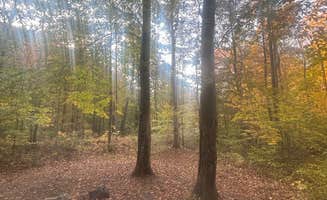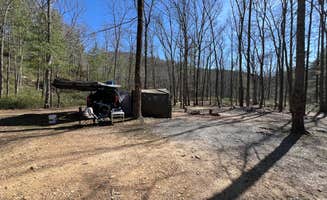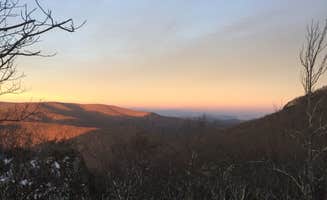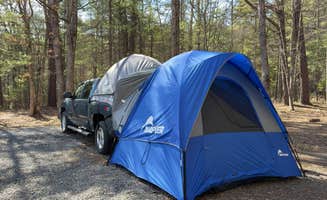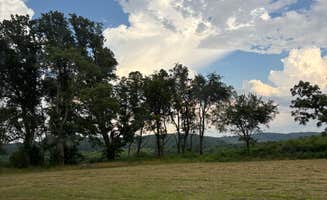Dispersed camping areas near Natural Bridge, Virginia offer remote sites in the Jefferson and George Washington National Forests at elevations between 1,500-2,500 feet. These primitive camping options provide solitude amid hardwood forests and small mountain streams, with seasonal temperature swings that can drop below freezing even in late spring. Most sites lack formal amenities but feature natural surroundings that change dramatically with each season.
What to do
Hiking on nearby trails: The Spy Rock area offers challenging trails with scenic rewards. "The hike up is brutal but the top is absolutely worth it... It's literally just the top of a mountain, nothing but what you carry up with you," reports Emily T. The summit provides 360-degree views of the Shenandoah Valley.
Fishing opportunities: Braley Pond Dispersed Camping & Day Use Area provides stocked fishing waters. "The pond is stocked with trout in season, check DGIF site for dates," notes Paul P. Another camper adds, "The pond is stocked with trout, so small groups of fisherpeople came and went."
Rock scrambling: Some sites near Natural Bridge offer natural climbing opportunities. Sam M. notes about the Spy Rock area, "Another cool thing about this area is that there's some fairly nice bouldering to be found near the top. Some of the routes are a little under maintained and mossy, but there are some fun ones."
What campers like
Creek access for cooling off: Many Dispersed Camping Site off FR 812 visitors appreciate the water features. David B. notes it has "easy access to the stream," while another camper describes it as "a large open space with several flat areas for tents" that includes "hiking trails and easy access to the stream."
Stargazing opportunities: The minimal light pollution makes for exceptional night skies. At Braley Pond, Austin K. reports, "The stars were amazing!" The elevation and distance from urban areas creates prime conditions for astronomy enthusiasts, particularly during new moon phases.
Stone cooking features: Several sites include unique campfire setups. At George Washington National Forest off 812, Sawyer B. found "a fire ring and man made stone oven at the site we chose," offering opportunities beyond basic campfire cooking.
What you should know
Seasonal road conditions: Access roads require planning ahead. At Reservoir Road Dispersed Campsite, SJ W. warns it's "about 5 miles of dirt road to get to it" and Derek D. confirms these are "multiple spots along reservoir rd" but accessibility varies with weather.
Water filtration necessity: Natural water requires treatment. Ryan L. notes about George Washington National Forest off 812, "Fire ring and river are right there, no toilets," meaning you need to bring filtration equipment for all water consumption.
Cell service limitations: Expect to be offline. Clayton S. reports at Poor Farm Dispersed Recreation Area, "No signal, so make sure you have a map or know which way you came." This isolation extends to most primitive camping areas within 20 miles of Natural Bridge.
Tips for camping with families
Choose sites with stream exploration: Kids enjoy natural water features. Amy S. says about Braley Pond Dispersed Recreation Area, "Though you can't swim in the lake, we did wade the stream, which was cold and clear and beautiful." These shallow creek areas provide natural entertainment for children.
Look for multi-site arrangements: Some areas accommodate group camping better than others. Kelly K. found at George Washington National Forest off 812 that "there were 4-5 additional site & we got one for 3 nights. They are all lovely & creekside with fire pits."
Check for basic facilities: A few primitive sites offer minimal amenities. Evan P. notes about Braley Pond, "A pit toilet is located at the picnic site," making it more manageable for families with young children who might struggle with true backcountry camping.
Tips from RVers
Clearance requirements: Some forest roads present challenges for larger vehicles. SJ W. mentions regarding George Washington National Forest off 812 that you "need some clearance in some spots," though they managed in a van, noting, "Multiple road sites that fit my van with room to spare."
Size-appropriate site selection: Not all dispersed sites accommodate larger rigs. At James River Wildlife Management Area, L H. notes, "For me being in the 29 foot classy, I opted to park it in a field/parking area at the entrance," showing the importance of selecting appropriate sites for your vehicle size.
Permit requirements: Some areas require advance permission. Zach K. explains about James River WMA, "You simply need to purchase either a daily or annual access pass from the DWR website and then report which days you will be staying at the WMA—it's currently $23 for the annual pass."


